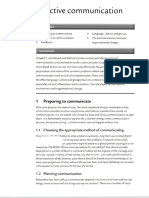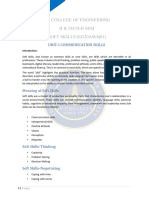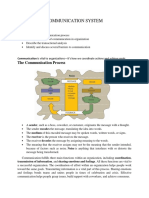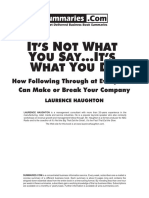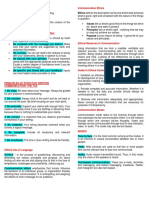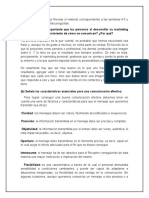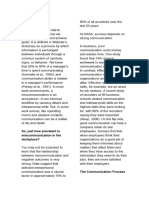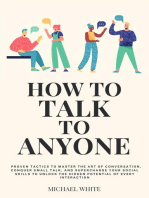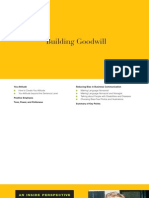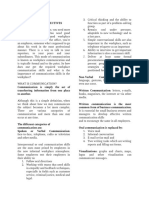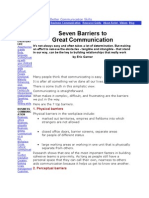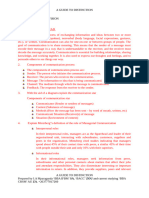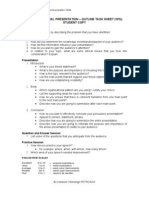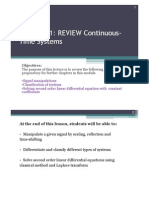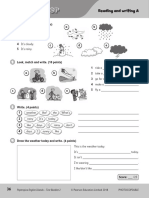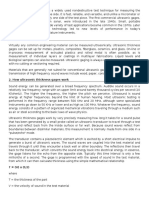Clarity Factor Summary
Clarity Factor Summary
Uploaded by
jwodCopyright:
Available Formats
Clarity Factor Summary
Clarity Factor Summary
Uploaded by
jwodOriginal Title
Copyright
Available Formats
Share this document
Did you find this document useful?
Is this content inappropriate?
Copyright:
Available Formats
Clarity Factor Summary
Clarity Factor Summary
Uploaded by
jwodCopyright:
Available Formats
The Clarity Factor
The Four Secrets to Being Clearly Understood
by Ray DiZazzo
Sourcebooks © 2000
107 pages
Focus Take-Aways
Leadership
• Speaking and listening effectively will bring you money and happiness.
Strategy
Sales & Marketing • Without realizing it, many executives develop poor communications habits.
Corporate Finance
Human Resources • The “Clarity Factor” involves a four-step process: focusing the message, winning
Technology
the listener’s attention, breaking down personal barriers and listening.
Production & Logistics
• Some people communicate verbally with effectiveness and clarity. Some don’t.
Small Business
Economics & Politics • To communicate clearly, you must know what you want to say before you say it.
Industries & Regions
Career Development • Make certain that your listener is willing and able to receive your message.
Personal Finance
Self Improvement
• Navigate your listener’s emotional barriers, which are known as distortion factors.
Ideas & Trends
• Open listening is the final step in communicating clearly.
• To communicate effectively, analyze every message you send before sending it.
• Clear communications save time, reduce stress and avoid unnecessary frustration.
Rating (10 is best)
Overall Applicability Innovation Style
6 6 6 7
Visit our website at www.getAbstract.com to purchase individual abstracts, personal subscriptions or corporate solutions.
getAbstract is an Internet based knowledge rating service and publisher of book abstracts. Every week, subscribers are e-mailed a short abstract of a
different business book. Each abstract contains an overview of essential ideas from the entire book. Excerpts from this book are reprinted here with the
permission of the publisher. The respective copyrights of authors and publishers are acknowledged. All rights reserved. No part of this abstract may be
reproduced or transmitted in any form or by any means, electronic, photocopying, or otherwise, without prior written permission of getAbstract Ltd (Switzerland).
This summary is restricted to the personal use of Sheldon Bixby (sheldonbixby@hotmail.com)
Review
The Clarity Factor
Meet Gloria, harried boss, wife and mother. She’s an intelligent, competent and well-
intentioned person, so she can’t figure out why Marty, her terminally put-upon employee
resents her, why her husband Bill ignores her, or why conversations with her teenage son
Todd always turn into shouting matches. Through a series of enlightening interactions,
Gloria shows readers how seemingly hopeless relationships can be resurrected when
communications improve. Author Ray DiZazzo uses hypothetical examples to illustrate
his tips for clear communications. His narrative won’t win any literary awards, but it is
surprisingly effective at teaching readers how to communicate better. getAbstract.com
recommends his book to all managers, because your job hinges in large part on com-
municating effectively. Now is that perfectly clear?
Abstract
You Are What You Communicate
Journalists and broadcasters aren’t the only professionals in the communications busi-
ness. No matter what your profession, communication is your most important skill.
Speaking and listening effectively can bring you monetary reward and personal happi-
“Regardless of ness. Executives of large companies routinely cite communication skills as significant for
what each of us advancement. In marriages, poor communication is a major factor leading to discontent
does for a living,
we are all in the and divorce. Speaking and listening well are critical for professional and personal suc-
communication cess. Yet, few people spend time analyzing and improving their communications skills.
business.”
Without realizing it, many executives communicate poorly. To project a tough, no-non-
sense, results-oriented image, they often communicate tersely. This approach yields con-
fusion (subordinates and colleagues aren’t sure what the executive means), frustration
(misinterpretation leads to wasted effort) and bruised feelings (the executive’s commu-
nication style ignores the listeners’ points of view and emotions).
Clarity avoids frustration, reduces stress, saves time, makes communication rewarding
“How clearly we and enjoyable and produces a feeling of connection with others. This last advantage is
speak and listen especially important. We all want others to hear and understand us.
directly affects not
only the opportu-
nities that come A Simple, Four-Step Process
our way but also A verbal communication is more or less clear depending on how effectively you, as
the level of per- the speaker, state your piece. A verbal communication is a message. The speaker is the
sonal satisfaction
and happiness we sender, while the listener is the receiver. The clarity factor measures how effectively the
achieve as human speaker communicates according to these criteria:
beings.”
• Focusing the message.
• Motivating the listener to pay attention.
• Breaking through any personal barriers in the listener.
• Listening effectively.
The Clarity Factor © Copyright 2001 getAbstract 2 of 5
With these steps, any speaker can communicate in a way that any listener can under-
stand, no matter what emotional barriers might have existed before. Subtle nuances
govern human interactions. Communication is a recipe whose ingredients include words
and body language. The clarity factor is an unnoticeable but indispensable ingredient in
creating comprehension on both sides of a communication. When this ingredient is miss-
“Proper use of ing, however, communication muddles.
verbal communi-
cation skills can
not only calm and
Step One: Bringing the Message into Focus
streamline your To communicate clearly, you must know what you want to say before you say it. You can
day-to-day life but accomplish this by:
also expand your
sensitivity to the • Thinking about the message. The sender sharpens the focus of the message by con-
subtle dynamics
that govern all templating what needs to be said and deciding exactly how to say it.
human interac- • Removing emotions. Filter out your own emotions to ensure objectivity. This
tions.” removes the possibility that you will distort your message and, thus, increases its
accuracy.
Conduct these two checks before you utter a word, in any context — whether it’s in an
e-mail, at a staff meeting, in an employee gathering or at a lunch with a client. Repeat
this exercise until it becomes an effortless habit. Objectivity is very important at this
point in the communications process. You must acknowledge your feelings about your
“Very few listeners and adapt the message accordingly.
managers have
the luxury of plan- Consider the case of Gloria, who finds that her employee, Marty, is a chronic malcontent.
ning every com- When Gloria gives Marty an order, she typically speaks like this: “Martin, I need the
ment they make.
But with a little Connor files, ASAP.” This is terse and not especially specific. With an effort to improve
practice, we can her clarity, Gloria analyzes this message. Then she rephrases it in a precise way that
all make a quick masks her negative feelings toward Marty. Here’s her second try: “Martin, I need one
analysis of our
words a habit —
figure — the bottom-line equipment depreciation total from the Connor account — as
a mindset just like soon as you have a few seconds, please.” This second, improved message saves Marty
objectivity.” time. He needs to find only one document, rather than an entire bulky file. Also, Marty
just feels better about this request, largely because the tone is less demanding and the
word “please” is present.
After contemplating her communication patterns with Marty, Gloria realizes that his
poor attitude toward her has some validity. He is always resentful of her requests, but
Gloria remembers that she felt the same way about bosses she had in the past. They
“The Clarity Factor appeared arrogant and demanding, which frustrated her because she felt that they didn’t
is about people — know what they wanted. She realizes that poor communication is the root of resent-
what our words ment.
really mean, how
we really feel when Harried managers who don’t take the time to analyze their messages beforehand can
we say them and,
most of all, our send unfocused messages like these: “Why is it you’re always late?” “I need it soon.”
intense desire to “You need to improve your productivity.” “We’ve got to cut our costs right away.” “If you
be heard and don’t improve your customer relations, we’re in trouble.”
understood as
human beings.”
Step Two: Making the Listeners Listen
Now that you’ve decided exactly what you want to say, make sure that your listeners
are willing and able to receive your message. For listeners to hear your message, they
must momentarily make you, as the speaker, their highest priority. You can magnify your
listeners’ attention in three ways:
The Clarity Factor © Copyright 2001 getAbstract 3 of 5
• Interest — Make sure the subject of the message will interest your listeners.
• Importance — Be certain that the message is significant.
• Attention — Ask your listeners to interrupt what they are doing to pay attention.
“One hundred per- (Note that you haven’t yet delivered your message. You merely have set the stage for the
cent clarity is verbal communication.)
impossible. A
receiver will Consider one of Gloria’s interactions with her husband, Bill, who is working at his desk
always include
some of his or
at home. Gloria says, “Todd got in trouble at school again, Bill. We should discuss it.”
her own personal- Bill just grunts, barely acknowledging Gloria.
ity in interpreting
what you say.” Now, view this in the context of a message you can evaluate. All messages can be graded
in two ways: 1) On the clarity factor, or the effectiveness of the message itself, and 2)
On the “Receptivity Quotient,” or the willingness of the listener to receive the message.
In this particular communication, Gloria’s words are not wrong, in and of themselves.
They earn a clarity factor of 88%. But Bill isn’t paying attention to the message, so the
receptivity quotient is only 2%. Gloria’s immediate impression is that Bill is uncaring
“In order to speak
with clarity, the and arrogant.
person talking
must first clarify But Gloria realizes this isn’t the case — Bill does care about their son. She also recog-
his or her thoughts nizes that Bill places a high priority on work. He ignores her not out of spite but because
at the source, in
his or her own
he’s doing something that, to him, is more important. So Gloria modifies her message to
mind.” magnify the listener’s attention. She says, “Bill, please stop what you’re doing and listen
to me. We have to talk about something very important.” The clarity factor of this mes-
sage remains high, while the receptivity quotient shoots up to 92%. The difference is that
Gloria asks for Bill’s undivided attention.
Step Three: Breaking Down Emotional Obstacles
“The next step is Now that you know what you want to say and have gained your listeners’ undivided
to motivate the lis- attention, it’s time to send your message. Keep in mind, though, the obstacle of distor-
tener into giving tion. What you as the speaker mean to say isn’t necessarily what your listeners hear. To
top priority to the
speaker.”
reduce distortion, you must navigate distortion factors, including your listeners’ deep-
seated opinions, values and experiences. You can do this several ways:
Use precise words — Visual language is the opposite of vague language. Visual lan-
guage uses specific details to convey a message. For example, don’t merely say, “The
job is super.” Instead, say, “The job has great hours, high wages and lots of personal
“The Clarity Factor reward.” A speaker using vague language would say, “She’s getting really old.” But a
is a subtle, speaker using visual language would phrase the message this way: “She’s 89, weighs
essential element
only 92 pounds and sits hunched over in a wheelchair.” A speaker using vague language
that makes verbal
communication would say, “My new car is beautiful.” But a speaker using visual language would phrase
productive and the message more precisely: “My new car is a deep, shiny blue with graceful lines and
rewarding when dark leather upholstery.”
it’s at its best, cre-
ating brilliant clar-
ity of word and
Use analogies that give your listeners a frame of reference — A vague speaker would say,
thought.” “He was a tall guy.” A more powerful statement would be: “He was so tall, he could be
Magic Johnson’s body double.” The vague message of “She’s really mad” is more color-
ful when you say, “She’s so mad she threw the telephone at the wall.” Or a vague speaker
might say, “He’s very smart.” A metaphor would be more effective: “He’s a 27-year-old
Albert Einstein.”
The Clarity Factor © Copyright 2001 getAbstract 4 of 5
Ask if your listeners understand your message.
Revise the message if the listeners don’t understand.
“Once the person Gloria has a strained relationship with her teenage son, Todd. Their attempts at commu-
speaking has the nication invariably end in confrontation. Consider the following example of a message
listener’s attention, from Gloria to Todd: “When are you going to quit being so negative and destructive, and
the message can
be sent. The start listening to me?” This message is bound for a dismal receptivity quotient. To Todd,
object is to assure as the listener, the words are judgmental and accusatory, implying that he is “negative”
that it gets through and “destructive.” Gloria rethinks her message and tries an alternative: “Todd, you need
as closely as pos-
sible to the way to stop thinking about everything else and listen to what I have to say. It’s more impor-
the speaker has tant than you realize.” This message rates a receptivity quotient of 73%, largely because
visualized it.” it removes the emotion and blame from a simple request to conduct a conversation.
Step Four: Listening with Clarity
This step requires you to consider a role reversal, because as the speaker you must make
sure that you remove the emotional barriers you have about your message and interpret
the message as you intended. The keys to listening effectively are:
“The idea is to
learn to penetrate • Empathy — Your listeners must put themselves in your shoes.
or overcome barri- • Imagination — Try to visualize what you wish to communicate.
ers in other people
— or in yourself
if you’re receiving
When Gloria asks Todd to listen to her, he asks her to listen to him in the same way.
the message.” She’s defensive at first, but then realizes that the only way to repair their relationship is
to listen to her son without distorting his message through her own opinions, values and
experiences.
Open listening proves contagious. After Gloria listens openly to Todd, he listens to her
concerns. Their pattern of unpleasant and ineffective communications had prevented
either one of them from listening to the other without barriers, so both had deep-seated
negative feelings. The result of listening with empathy is that Gloria and Todd could
come to view each other positively again, which was certainly a big relief to Bill.
About The Author
Ray DiZazzo is an author, consultant, columnist and speaker. The Clarity Factor is his
seventh book. He has taught communications skills to employees of GTE and J.D. Power
and Associates and to the executive staff of the Kent City Council in England. DiZazzo
lives in Southern California.
Buzz-Words
Clarity factor / Distortion / Emotional barriers / Empathy / Message / Objectivity /
Receiver / Receptivity quotient / Sender / Visual language
The Clarity Factor © Copyright 2001 getAbstract 5 of 5
You might also like
- Transformer Lab ManualDocument68 pagesTransformer Lab ManualRolando Cruz100% (1)
- Communication Skills: Learn How to Talk to Anyone, Read People Like a Book, Develop Charisma and Persuasion, Overcome Anxiety, Become a People Person, and Achieve Relationship Success.From EverandCommunication Skills: Learn How to Talk to Anyone, Read People Like a Book, Develop Charisma and Persuasion, Overcome Anxiety, Become a People Person, and Achieve Relationship Success.Rating: 5 out of 5 stars5/5 (46)
- PD NotesDocument12 pagesPD Notesay273257No ratings yet
- Effective Communication in The Workplace (Ultimate Guide + Tips)Document1 pageEffective Communication in The Workplace (Ultimate Guide + Tips)Eyoh EffiongNo ratings yet
- Article 1 Forbes Your Business Communication SkillDocument3 pagesArticle 1 Forbes Your Business Communication SkillHole StudioNo ratings yet
- Professional Communication Module PDFDocument25 pagesProfessional Communication Module PDFapi-654101297No ratings yet
- But We Already Have A Company Bulletin To Tell Everyone What Is HappeningDocument6 pagesBut We Already Have A Company Bulletin To Tell Everyone What Is Happeningpratibha_1979No ratings yet
- Effective CommunicationDocument12 pagesEffective CommunicationAreej khanNo ratings yet
- Oral Communication 2 (Autosaved)Document57 pagesOral Communication 2 (Autosaved)Mohcine BenmouloudNo ratings yet
- TopicDocument18 pagesTopicDestrofan GamingNo ratings yet
- Effective CommunicationDocument138 pagesEffective CommunicationIrfan Qalamkar100% (2)
- Lý ThuyếtDocument16 pagesLý ThuyếtĐăng Khoa Nguyễn PhướcNo ratings yet
- Communication SkillsDocument7 pagesCommunication SkillscgoldcafeNo ratings yet
- Q 1: Are Communication Skills Acquired by Nature or by Nurture? ExplainDocument3 pagesQ 1: Are Communication Skills Acquired by Nature or by Nurture? Explainعلیزہ علیNo ratings yet
- Unit-1 Soft SkillsDocument9 pagesUnit-1 Soft SkillskoushikyerraguntlaNo ratings yet
- effective communicationDocument33 pageseffective communication70173381No ratings yet
- Business Communication Updated 081017 Last ClassDocument256 pagesBusiness Communication Updated 081017 Last ClassUmesh KaleNo ratings yet
- M-2 Interpersonal CommunicationDocument27 pagesM-2 Interpersonal Communicationrandom.use.and.stuffNo ratings yet
- 2023 COE9-17 UHU003 Introduction and JohariDocument16 pages2023 COE9-17 UHU003 Introduction and Johariarjun AryaNo ratings yet
- 3ch Ob Bus 209 CommunicationDocument66 pages3ch Ob Bus 209 CommunicationJasmine Ahmed Joty (161011023)No ratings yet
- Effective CommunicationDocument138 pagesEffective CommunicationBaharin Hashim100% (2)
- 7 Communication Skills Every Entrepreneur Must MasterDocument3 pages7 Communication Skills Every Entrepreneur Must MasterRio BoncalesNo ratings yet
- CommunicateAtYourBest PDFDocument22 pagesCommunicateAtYourBest PDFMazher JavaidNo ratings yet
- Features of An Effective CommunicationDocument11 pagesFeatures of An Effective CommunicationJuanMiguel imperialNo ratings yet
- The Seven Deadly Skills of Communicating: by Ros JayDocument12 pagesThe Seven Deadly Skills of Communicating: by Ros JayOdia Etinosa JuliusNo ratings yet
- Communication SystemDocument4 pagesCommunication Systemfilnara raguroNo ratings yet
- Bridge The GapDocument7 pagesBridge The Gapcafey panNo ratings yet
- GMRC Questions ADocument2 pagesGMRC Questions Arhea perez100% (1)
- 7 C's of CommunicationDocument12 pages7 C's of CommunicationMuskan SinghNo ratings yet
- Its Not What You Say... Its What You DoDocument9 pagesIts Not What You Say... Its What You Dowijido9671No ratings yet
- Purcom ReviewerDocument4 pagesPurcom ReviewerJudyann SisterCabauatanNo ratings yet
- Marketing PersonalDocument2 pagesMarketing PersonalLiset Jimenez espinozaNo ratings yet
- Mastering Connection: Unlocking the Secret Language of Effective CommunicationFrom EverandMastering Connection: Unlocking the Secret Language of Effective CommunicationNo ratings yet
- Unit One Written NotesDocument22 pagesUnit One Written NotesrifatbudhwaniNo ratings yet
- Ultimate Communications Guide WorkbookDocument8 pagesUltimate Communications Guide WorkbookSugumar SNo ratings yet
- DELL 4th Year StudentsDocument150 pagesDELL 4th Year Studentsbele yalewNo ratings yet
- Assignment 1 Importance of Communication SkillsDocument21 pagesAssignment 1 Importance of Communication Skillsertugrul shahNo ratings yet
- Presentation BasicsDocument8 pagesPresentation BasicsSian MalikNo ratings yet
- CommunicationDocument12 pagesCommunicationsjayceelynNo ratings yet
- Overcoming Communicati ON BarriersDocument13 pagesOvercoming Communicati ON BarriersJasmine CristobalNo ratings yet
- The Features of Effective CommunicationDocument7 pagesThe Features of Effective Communicationkawaiijoon100% (1)
- How to Talk to Anyone: Proven Tactics to Master the Art of Conversation, Conquer Small Talk, and Supercharge Your Social Skills to Unlock the Hidden Potential of Every InteractionFrom EverandHow to Talk to Anyone: Proven Tactics to Master the Art of Conversation, Conquer Small Talk, and Supercharge Your Social Skills to Unlock the Hidden Potential of Every InteractionNo ratings yet
- Salescology_Writing Effective EmailsDocument22 pagesSalescology_Writing Effective EmailseldadreadingsNo ratings yet
- Interpersonal SkillsDocument26 pagesInterpersonal Skillssyedazra93% (14)
- Kitty Locker Ch2Document24 pagesKitty Locker Ch2Mahmudur Rahman100% (4)
- Effective CommunicationDocument54 pagesEffective Communicationkaleem ahmedNo ratings yet
- Did I Say That - EbookDocument14 pagesDid I Say That - EbooktotalyouNo ratings yet
- SSB201 Chapter 1Document21 pagesSSB201 Chapter 1ngoclvmcs180885No ratings yet
- Emotional Intelligence (2ND Year) Notes For English MediumDocument34 pagesEmotional Intelligence (2ND Year) Notes For English Mediummybike31No ratings yet
- 1 Effective Oral Presentation in A WorkplaceDocument30 pages1 Effective Oral Presentation in A WorkplaceNicole SacroNo ratings yet
- Chapter 3 - ADMINISTRATIVE & OFFICE MGTDocument5 pagesChapter 3 - ADMINISTRATIVE & OFFICE MGTerika madridNo ratings yet
- DF 3Document7 pagesDF 3itzmadan.2005No ratings yet
- Author Insights Bob DignenDocument5 pagesAuthor Insights Bob DignenEmily JamesNo ratings yet
- Chap 2Document15 pagesChap 2Najia NasreenNo ratings yet
- Seven Barriers To Great CommunicationDocument5 pagesSeven Barriers To Great Communicationsunil9942047143No ratings yet
- Week 9 HandoutsDocument36 pagesWeek 9 Handoutsapexpredator4aNo ratings yet
- Communication RevisionDocument50 pagesCommunication RevisionLainoNo ratings yet
- Communication SkillDocument24 pagesCommunication SkillJeet Munna100% (2)
- Mcmanus Fall2008 PDFDocument18 pagesMcmanus Fall2008 PDFCarolina BárbaraNo ratings yet
- Wk11-Persuasive Oral Presentation - The Outline10Document2 pagesWk11-Persuasive Oral Presentation - The Outline10lovetilyouhateNo ratings yet
- Derek Halpern ExposedDocument17 pagesDerek Halpern ExposedervoNo ratings yet
- Change Initiative PDFDocument6 pagesChange Initiative PDFDetherina BasilioNo ratings yet
- Magnetic Fields, Hall Effect and Electromagnetic InductionDocument12 pagesMagnetic Fields, Hall Effect and Electromagnetic Inductionwina ariffNo ratings yet
- Polygraphy Lab ManualDocument38 pagesPolygraphy Lab ManualPat Mandawe100% (1)
- PRE CALCULUS 2ndQ SLMDocument45 pagesPRE CALCULUS 2ndQ SLMWilmar RonioNo ratings yet
- Ese562 Lect01Document35 pagesEse562 Lect01ashralph7No ratings yet
- Miqyasglobal - ProfileDocument12 pagesMiqyasglobal - Profileأ. محمد عمر عبدالرحيمNo ratings yet
- Budget and Budgetary Control Literature ReviewDocument7 pagesBudget and Budgetary Control Literature Reviewafmzsprjlerxio100% (1)
- Ihyau Rohmah - B73214064Document105 pagesIhyau Rohmah - B73214064shafura puyaNo ratings yet
- Lesson Plan Juniors 06 Saturday UAdeO June 1st Teacher Emma BonDocument2 pagesLesson Plan Juniors 06 Saturday UAdeO June 1st Teacher Emma BonEmma BonNo ratings yet
- Lifting Lugs - PRESSURE-VESSEL-Handbook-Eugene-F-Megyesy-12th-2001Document1 pageLifting Lugs - PRESSURE-VESSEL-Handbook-Eugene-F-Megyesy-12th-2001AntonioNo ratings yet
- Group 2 Het Schoter Waste Management Group Leader - Anokhee TammanaDocument6 pagesGroup 2 Het Schoter Waste Management Group Leader - Anokhee Tammanaapi-440622270No ratings yet
- (PDF) A Business Plan On Fish Farming in Kashere Community Gombe State - S225908Document14 pages(PDF) A Business Plan On Fish Farming in Kashere Community Gombe State - S225908photosynergy technologyNo ratings yet
- Introduction To Fluid Mechanics - Ch01Document5 pagesIntroduction To Fluid Mechanics - Ch01Nguyễn Hồng QuânNo ratings yet
- Energy Tapping Identifier Through Wireless Data AcquisitionDocument4 pagesEnergy Tapping Identifier Through Wireless Data Acquisitionsunil singhNo ratings yet
- As-12 AirSepDocument2 pagesAs-12 AirSepSteven100% (1)
- PMK-2 - Nguyen Tan Anh - Reflective JournalDocument10 pagesPMK-2 - Nguyen Tan Anh - Reflective JournalTan Anh NguyenNo ratings yet
- 05 - Chapter 2Document44 pages05 - Chapter 2Nalabolu Eshwari EshwariNo ratings yet
- Advances in Civil Engineering - 2023 - Arabani - The Effect of Wetfix and Nanohydrated Lime Additives On Bitumen Aging andDocument17 pagesAdvances in Civil Engineering - 2023 - Arabani - The Effect of Wetfix and Nanohydrated Lime Additives On Bitumen Aging andali.amh.1312No ratings yet
- Islands Level 2 Global Test Unit 8Document4 pagesIslands Level 2 Global Test Unit 8Romina NutricionNo ratings yet
- Number 66 2021Document108 pagesNumber 66 2021Mariano Salomon PaniaguaNo ratings yet
- Retaining Wall Design - by Pillai & Menon PDFDocument23 pagesRetaining Wall Design - by Pillai & Menon PDFSaurabh SinghNo ratings yet
- CSP 9Document17 pagesCSP 9Mai Trương Vũ NgọcNo ratings yet
- Reading Is The Inhale Writing Is The ExhaleDocument2 pagesReading Is The Inhale Writing Is The ExhaleIsabela Act CisNo ratings yet
- Venteicherk Asg3 Peer RVW FormDocument2 pagesVenteicherk Asg3 Peer RVW Formapi-238107999No ratings yet
- Ultrasonic Thickness Measurement PrincipleDocument5 pagesUltrasonic Thickness Measurement PrincipleM Hamza NadeemNo ratings yet
- CNE 2ssolvedDocument2 pagesCNE 2ssolvedMayur PoteNo ratings yet
- Numeric in Mine Legislation-2019Document68 pagesNumeric in Mine Legislation-2019Srirama gopalNo ratings yet







